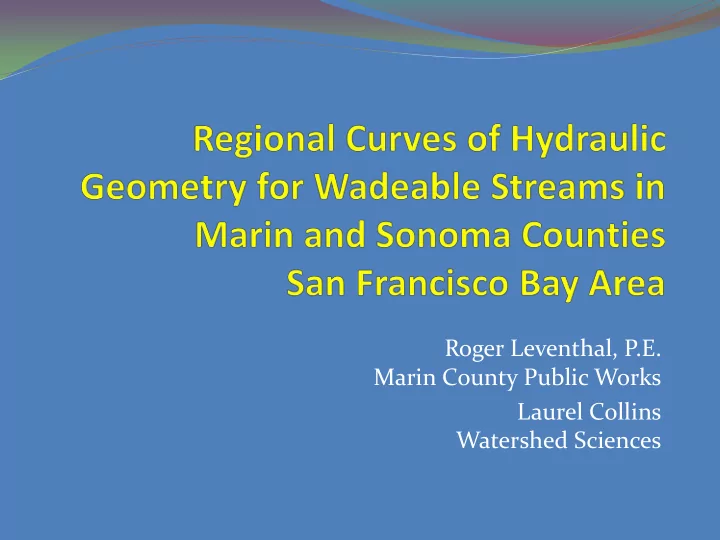

Roger Leventhal, P.E. Marin County Public Works Laurel Collins Watershed Sciences
Background Funded in 2009 under EPA 2100 Grant for $30k and managed by SFEP Project Goals: Update original Leopold curve for SF Bay Area for Marin and Sonoma for area/width/depth Assess major factors (i.e. precip, geology, % urbanization) impact channels Collected and analyzed 58 data points Phase I report analyzes for several variables [Hopefully] a Phase II to further stratify and analyze data
Luna Leopold and the U.S.G.S. “In the 1950's a group of U.S. Geological Survey researchers led by Luna Leopold ushered in modern process geomorphology with an aggressive campaign to measure rates of geomorphological processes and explain the physics underlying these processes.” “Leopold's approach involved coupling field observations and measurements with theoretical models to explain geomorphological processes. “
Major Downstream Trends discharge width depth velocity gradient grain size
Bankfull or Effective Flow For alluvial rivers - “author of their own geometry” “The flow that over time forms the equilibrium channel dimensions” ~ 1.5 yr RI flow Must be found from bankfull indicators in field
Hydraulic Geometry and Creek Restoration Channel parameters described with power functions using Q as the sole independent variable: BFw = aQ b BFd = cQ f BFv = kQ m An important design tool used in many restoration project designs – regional curves are plots of “stable” or “equilibrium” sites Plots of field sites are “regional curves”
1978 - One curve for SF Bay Region at 30” MAP (curve A) Data points not plotted Assumed 1.5 RI and plotted A, W and D from gaging records at USGS gage sites Best done as local dataset (our project)
Finding bankfull elev…textbooks Finding bankfull elevation is not always easy A depositional feature not always present Most Bay Area streams are incising
Finding bankfull in the real world…
Adjustments in the Fluvial System
http://wmc.ar.nrcs.usda.gov/technical/HHSWR/G eomorphic/index.html
Marin Field Sites
Sonoma County Sites
Data Collection and Analysis Multiple Field Parameters BF Width and Elevation Pebble Counts Profile and Cross-Section Surveys Many more GIS Analysis Drainage area %imp and channelized network Precipitation Calculated Parameters BF flow, area, velocity, W/D ratio, SS many more
Results… Over 20 different graphs and tables in the report Showing only a few today New analysis of the required floodplain width and chanelized network length
Slope and DA Frequency Plots 14 sites > 3% slope – fills in data gap for steeper streams Fills in data gap for smaller streams
Dominant Geomorphic Setting Types 1. Wide alluvial valley 2. Narrow predominantly alluvial valley 3. Moderately wide alluvial valley 4. Alluvial fan* 5. Narrow, predominantly colluvial valley or canyon 6. Steep, mostly bedrock confined canyon 7. Plain, often uplands transitional to tidelands
Rosgen Classification
USGS Gage Sites Approximate Bankfull Discharge Reservoir Site Recurrence (cfs) Upstream Interval (years) Corte Madera Creek at 953 Yes 1.3 Ross Gage Site 11460000 Lagunitas Creek at 842 Yes 1.1 Samuel P. Taylor Park, Gage Site 1146400 Novato Creek at Novato, 303 Yes 1.2 Gage Site 11459500 Sonoma Creek at Agua 3139 No 1.2 Caliente, Gage Site 11458500 Walker Creek near 1065 Yes 1.5 Marshall, Gage Site 11460750 Note: Recurrence intervals were determined from a flood frequency analysis of Peak Annual flows from USGS data.
Regional Curve – X-Sectional Area
Regional Curve – Bankfull Width
Regional Curve – Bankfull Depth
Regional Curve – Flood-Prone Width
Regional Curve – Flood-Prone Width
Degree of Channelization
Next Steps Looking for Phase II funding to: Perform more field survey at focus sites Statistical data analysis and segregation Look for riparian signature on floodplain (part of SFEI team) – focus on required floodplain width Assess water quality impacts of sediment production from channel erosion Prepare a formal methods and procedures guidance document Publish findings and prepare presentations of findings and use regional curves for creek restoration design and watershed analyses
Big Thanks To… Judy Kelly, Jennifer Krebs, Paula Trigueros and James Muller of SFEP Luisa Valiela of the EPA A.L. Riley of the RWQCB
Recommend
More recommend